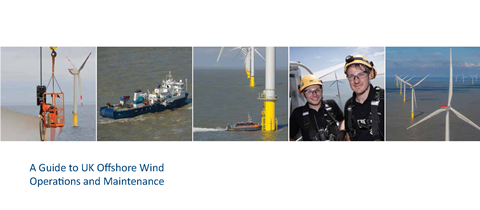
After a decade of focus on installation, the industry is now turning its attention to operations and maintenance. Over the coming years, wind farm owners and turbine manufacturers will want to realise more from their investments by ensuring equipment runs efficiently for as long as possible.
So I was highly interested to read the Guide to UK Offshore Wind Operations and Maintenance, in which DNV GL (formerly GL Garrad Hassan) presents comprehensive insight into the O&M market for offshore wind in the UK.
This guide is an excellent piece of work and highly recommended reading. We can thank Scottish Enterprise and The Crown Estate for commissioning this study. I spoke to Oscar Fitch-Roy, one of DNV GL’s authors of the guide, to learn more about what they wanted to achieve with it.
The guide provides a clear definition of what offshore wind O&M is and looks at seven main categories within offshore wind operations and maintenance:
- Offshore logistics
- Back office, administration and operations
- Onshore logistics
- Export cable and grid connection
- Turbine maintenance
- Array cable maintenance
- Foundation maintenance
DNV GL, the author of the guide, is a highly respected renewable energy advisory organisation.
Oscar Fitch-Roy (pictured on the left), who is Senior Policy Consultant at DNV GL, explained to me what was behind the commissioning of the guide:
“The offshore wind industry is moving rapidly from a situation where the focus is on installation of offshore wind turbines to operations and maintenance. Scottish Enterprise and the Crown Estate have both a keen interest in the sector and they are aware that operations and maintenance will become an increasingly large part of it. But there seems to be a significant lack of awareness about what that will mean.
“Scottish Enterprise and the Crown Estate have a remit to raise awareness of offshore wind. The guide’s intention was to look at the trends in the offshore wind market and help various players in the industry to confront uncertainty about the future. More and more wind parks are being commissioned, but there is a lot of uncertainty about how the wind parks will be maintained, and we’ve tried to bring some of the key issues to light in this guide.
“We were commissioned to produce the report, which was based on extensive research and interviews with knowledgeable people in the industry based in the UK. We have worked with many different operational wind parks and we have a clear understanding of challenges, both technically and commercially.”
A dynamic industry with growing opportunities
Offshore wind is big business in the UK. Oscar Fitch-Roy made clear the potential of the market, which according to GL Hassan’s research is projected to reach 2 billion pounds in total annual spend by the mid 2020s. He compares it to the passenger aircraft maintenance industry in the UK, expecting offshore wind to reach about the same order of magnitude.
He sees the dynamics of the market as very fluid, likely consisting of a very diverse range of smaller companies:
“This offers exciting opportunities, with the potential for lots of new companies to provide relevant services. Of course, no-one knows how it will pan out, but there is certainly potential. The opportunity is there now, and anyone involved in the sector now will have a role to play in the future.”
One of the particularly interesting aspects of the O&M guide is the summary of some recent innovations and solutions that the market may be looking at.
One of a kind
Oscar Fitch-Roy believes that the offshore wind industry is unique. He sees it as half way between a bespoke industry and a serial volume industry:
“The industry has some of the logistical challenges of the oil and gas industry, but the wind turbines bring large volumes seen in manufacturing. The industry is also in a unique position because of the sheer scale of the turbines, which is vast.
He believes that it is important to increase awareness of O&M of offshore wind parks, largely because of the unique challenges it presents. Challenges require solutions, and for those who have found a way to solve a problem, it is highly likely there will be a market for them.
Setting an industry standard
DNV GL’s offshore wind O&M guide is the result of several months’ research, where a wide range of technical and market experts were consulted. It has been put together in a reader-friendly format and is structured so it is easy to find relevant information. For example, it gives you an excellent overview of how O&M functions, or you can quickly look up a specific area, such as array cables. Although you don’t have to read it from front to back, I think it would be useful to do so!
Even though this guide is based on research from the UK market, I think it is possible to extrapolate towards the North Sea and other parts of Europe, and that it gives an idea of the need for O&M expertise – and the size of the market – in offshore wind parks in other regions.
Find out more about Scottish Enterprise, The Crown Estate and DNV GL Group.

